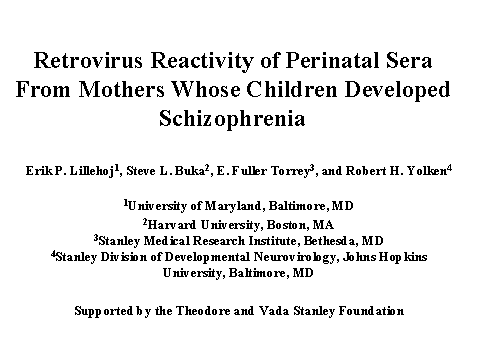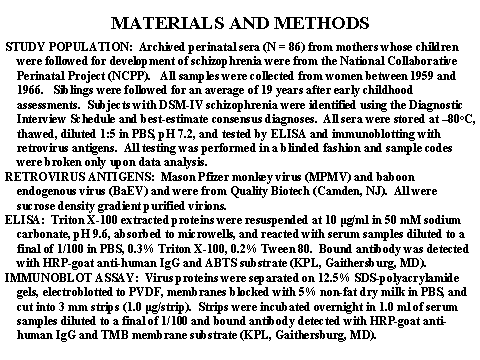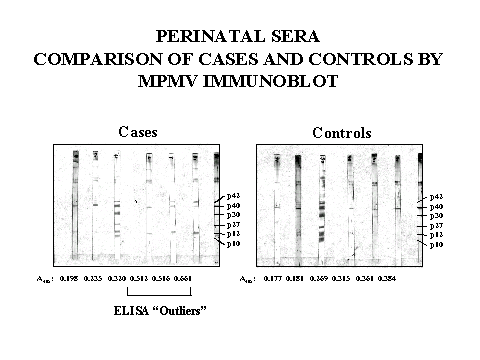RETROVIRUS REACTIVITY OF PERINATAL
SERA FROM MOTHERS WHOSE CHILDREN DEVELOPED SCHIZOPHRENIA
Erik P. Lillehoj, Steve Buka, E.
Fuller Torrey, Robert H. Yolken
Previous studies have postulated that
human endogenous retroviruses may contribute to the etiology of some cases of
schizophrenia (Yolken et al., Brain Res. Rev. 31, 193-199, 2000). To
further characterize the relationship between retroviruses and schizophrenia, we
have undertaken a systematic analysis of retrovirus exposure, as assessed by
virus reactive serum antibodies, in various populations of patients with
schizophrenia or matched controls. We showed previously by ELISA and
Western blot analyses that antibodies against non-human primate retroviruses,
predominately directed against gag encoded proteins, were present at
significantly greater frequencies in patients with acute onset schizophrenia
compared with unaffected controls (Lillehoj, et. al., J. Neurovirol. 6, 492-497,
2000). The antigenic determinants reacting with these antibodies presumably
originated from regions of gag genes conserved between monkey and human
retroviruses. While our initial study lended support to the hypothesis
that replication of a human retrovirus in patients with schizophrenia may
explain some of the clinical and epidemiological features of this disease, we
examined a relatively small group of patients (n=38) selected from a clinical
population at the University of Heidelberg, Germany. In this follow-up study, we
extended our initial observations by analysis of the larger, more diverse
patient population: (1) a panel of sera from Chinese schizophrenia patients and
matched controls (N=40), (2) a set of matched sera from monozgotic twins
discordant for schizophrenia (N=50), and (3) a collection of perinatal sera from
mothers whose children subsequently were followed for development of
schizophrenia (N=86). Of these 3 populations, the perinatal sera gave the
most interesting results. By MPMV ELISA, all control samples (N=41) had OD450
<0.4. Of 45 sera from mothers with children who went on to develop schizophrenia, 3 with displayed elevated reactivity to MPMV, 2 in the range of 0.5-0.6 and one with OD450 >0.6 (p<0.001). Interestingly, these 3 "outlier" schizophrenia samples did not show different Western blot banding patterns compared to control samples, either in terms of the number of reactive bands or band intensities. Essentially identical results were obtained using BaEV as the retroviral antigen with regards to both the ELISA reactivity profiles and Western blot banding patterns. Further studies using a larger panel of perinatal samples (N=236) are currently underway to confirm these preliminary findings. These results provide independent support for our initial observations describing the association between retroviruses and schizophrenia that may someday prove beneficial for patient diagnosis and/or treatment. (Supported by the Theodore and Vada Stanley Foundation).
Poster:
 |
 |
 |
